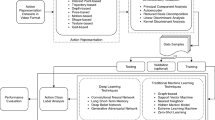Abstract
Human action recognition fromskeletal data is an important and active area of research in which the state of the art has not yet achieved near-perfect accuracy on many wellknown datasets. In this paper, we introduce the Distribution of Action Movements Descriptor, a novel action descriptor based on the distribution of the directions of the motions of the joints between frames, over the set of all possible motions in the dataset. The descriptor is computed as a normalized histogram over a set of representative directions of the joints, which are in turn obtained via clustering. While the descriptor is global in the sense that it represents the overall distribution of movement directions of an action, it is able to partially retain its temporal structure by applying a windowing scheme.
The descriptor, together with a standard classifier, outperforms several state-of-the-art techniques on many wellknown datasets.
Similar content being viewed by others
References
Yao A, Gall J, Fanelli G, and Van Gool L J. Does human action recognition benefit from pose estimation? In: Proceedings of the British Machine Vision Conference. 2011
Estrebou C, Lanzarini L, Hasperué W. Voice recognition based on probabilistic SOM. In: Proceedings of XXXVI Congreso Latinoamericano de Informática (CLEI). 2010
Hussein M E, Torki M, Gowayyed M A, El-Saban M. Human action recognition using a temporal hierarchy of covariance descriptors on 3D joint locations. In: Proceedings of the 23rd International Joint Conference on Artificial Intelligence. 2013, 2466–2472
Barnachon M, Bouakaz S, Boufama B, Guillou E. Ongoing human action recognition with motion capture. Pattern Recognition, 2014, 47(1): 238–247
Gowayyed M A, Torki M, Hussein M E, El-Saban M. Histogram of oriented displacements (HOD): describing trajectories of human joints for action recognition. In: Proceedings of the 23rd International Joint Conference on Artificial Intelligence. 2013, 1351–1357
Ofli F, Chaudhry R, Kurillo G, Vidal R, Bajcsy R. Sequence of the most informative joints (SMIJ): a new representation for human skeletal action recognition. Journal of Visual Communication and Image Representation, 2014, 25(1): 24–38
Cho K, Chen X. Classifying and visualizing motion capture sequences using deep neural networks. 2013, arXiv:1306.3874
Li W Q, Zhang Z Y, Liu Z C. Action recognition based on a bag of 3D points. In: Proceedings of IEEE Computer Society Conference on Computer Vision and Pattern Recognition Workshops. 2010, 9–14
Kohonen T. The self-organizing map. Neurocomputing, 1998, 21(1): 1–6
Fothergill S, Mentis H, Kohli P, Nowozin S. Instructing people for training gestural interactive systems. In: Proceedings of the SIGCHI Conference on Human Factors in Computing Systems. 2012, 1737–1746
Ellis C, Masood S Z, Tappen MF, Laviola Jr J J, Sukthankar R. Exploring the trade-off between accuracy and observational latency in action recognition. International Journal of Computer Vision, 2013, 101(3): 420–436
Wang J, Liu Z C, Chorowski J, Chen Z Y, Wu Y. Robust 3D action recognition with random occupancy patterns. In: Proceedings of the 12th European Conference on Computer Vision. 2012, 872–885
Wang J, Liu Z C, Wu Y, Yuan J S. Mining actionlet ensemble for action recognition with depth cameras. In: Proceedings of IEEE Conference on Computer Vision and Pattern Recognition. 2012, 1290–1297
Negin F, Özdemir F, Akgül C B, Yüksel K A, Erçil A. A decision forest based feature selection framework for action recognition from RGB-Depth cameras. Lecture Notes in Computer Science, 2013, 7950: 648–657
Jiang X B, Zhong F, Peng Q S, Qin X Y. Robust action recognition based on a hierarchical model. In: Proceedings of IEEE International Conference on Cyberworlds. 2013, 191–198
Author information
Authors and Affiliations
Corresponding author
Additional information
Franco Ronchetti is an advanced PhD student in computer science at the School of computer Science of Universidad Nacional de La Plata (UNLP), Argentina. He is a teaching assistant for Grade Courses at the National University of La Plata. His reasearch area is related to soft-computing and intelligent systems, with focus on dynamic problems such as signal processing and pattern recognition.
Facundo Quiroga received his BS in computer science from the Faculty of Informatics of Universidad Nacional de La Plata (UNLP), Argentina in 2014. He is currently a PhD Student in the same faculty, doing research work at the III-LIDI Institute. His main research fields comprise machine learning and signal processing, with applications in action recognition and biomedical data analysis. He is also interested in computational neuroscience and the interplay between artificial neural networks and biological ones.
Laura Lanzarini is a full-time Head Professor teaching in Data Mining topics since 2001 at the School of Computer Science of Universidad Nacional de La Plata (UNLP), Argentina. She is a Guest Head Professor at the National University of Tierra del Fuego and Guest Professor of the Post-Grade Program at the University of Buenos Aires, Argentina. She is interested in subjects pertaining to the design and development of adaptive application based on neural networks, swarm intelligence, and other metaheuristics applicable to Data Mining and Text Mining problems.
Cesar Estrebou is a PhD student in computer vision, image processing and graphic computing at the School of Computer Science of Universidad Nacional de La Plata (UNLP), Argentina. Since 2008, He is a teaching assistant (assignments supervisor) for Grade Courses at the National University of La Plata. He has been carrying out research activities since 2005 at the Institute of Research in Computer Science III-LIDI in areas related to intelligent systems, real-time systems and software engenieering.
Rights and permissions
About this article
Cite this article
Ronchetti, F., Quiroga, F., Lanzarini, L. et al. Distribution of action movements (DAM): a descriptor for human action recognition. Front. Comput. Sci. 9, 956–965 (2015). https://doi.org/10.1007/s11704-015-4320-x
Received:
Accepted:
Published:
Issue Date:
DOI: https://doi.org/10.1007/s11704-015-4320-x




